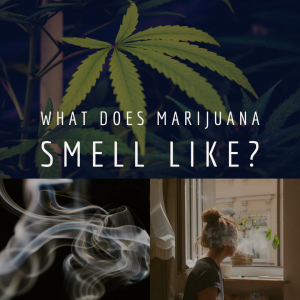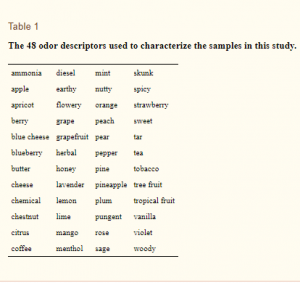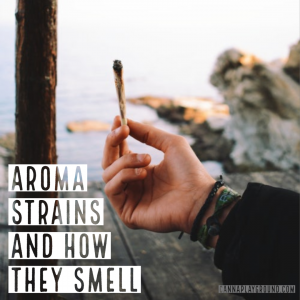
Marijuana contains a very distinct smell that most people will recognize. Some call it a musky odor while others associate it with the smell of a skunk. With the increased legality that is occurring in the United States and abroad, the smell of marijuana is becoming more common to run into whether it is simply walking down the street or even walking in your building’s hallway.
What does a marijuana plant smell like?
As a plant, marijuana gives off different smells over the course of its life cycle. While the plant is in its early stages, the smell is less potent, however, as it grows older, the smell becomes more weedy, piney or skunky. The smell is heightened when the plant is exposed to heat, so one may notice a stronger stench on a warm weather day. And finally, as the plant flowers and blooms, one will experience a heightened scent that is unforgettable.
What does weed smell like at the point of purchase?
At the point of purchase, the smell weed gives off a very different scent compared to when it’s a plant. The intensity of the scent at the point of purchase is highly dependent on how long it has been stored as time effects the moisture in the weed. When drier, marijuana’s smell is quite stronger than when moisture is retained.
At the point of purchase, weed gives off a more earthy, herbal and woody smell. A lot of users have described the smell to have a little bit of citrus, apple or plum aroma in it.
How weed smells when smoking it
Every strain has its own dominant notes which range from a skunky smell to one that smells like lemongrass. When lighting up a bowl or smoking a joint, these notes will be quite apparent. Other factors that will affect the smell can be a fruity flavored rolling paper that is used or even the smoke itself. The smell is so strong that often an entire room or portion of a house can reek of marijuana for quite a period of time. When smoking in a car with the windows closed, often referred to as hotboxing, the scent can last for a long period of time.
How weed smells on a person who just finished smoking it
Just like the smell of fudge being cooked in a chocolate shop, weed’s smell on someone who just finished smoking is quite distinctive. The smell clings to everything, hair, skin, clothing, and more. However, the smell is not as powerful or noticeable as the smell of a cigarette. On a person who just finished smoking weed, you should expect a skunky smell. The smell has a blend of fire, smoke and a distinct layer of sweat as well as the person’s natural body scent or cologne. Most people describe this smell to be a blend of slightly foul to faintly sweet scent. Of course this is very subjective.
What synthetic weed smells like
With every passing day, the scope on weed and the cannabis industry as a whole gets broader. For those unfamiliar with the term synthetic weed, also referred to as k2 or mamba, it is weed developed in a lab and mixed with several other components and chemical compounds. Synthetic marijuana differs from weed as there’s no yardstick of regulation. This means it can contain nearly anything imaginable which means its smell will vary greatly.
Why does weed smell the way it does?
Not all marijuana gives off an illicit odor as some strains have an amazing aromatic fragrance. If this is the case for some weed strains it begs the question ‘why then does some weed strain smell the way they do?’ The answer to this million-dollar question lies ahead.
- Terpenes – Research has shown that the major reason for the skunky smell marijuana gives off is due to the “terpenes within the cannabis plant”. For those not familiar with the word, terpenes are aromatic (scented) oils produced in specific regions of a cannabis plant. These are the same glands responsible for the production of cannabinoids like THC and CBD. They color the various cannabis variations with distinctive flavors like:
- berry
- citrus
- pine
- mint
The major terpenes that can be found in the majority of cannabis products currently on the market include:
* Myrcene – This is the culprit responsible for the skunky smell weed gives off. Studies show that this terpene is the source of the unique aroma of weed. So when next you smell skunk and wonder where it comes from, just know it’s the myrcene. Research has shown that myrcene can also be found in hop vine flowers and has been a very useful resource in the medical world. A couple of its uses include:
- Used as a sedative.
- Used as a muscle relaxant
- Shown to have analgesic, hypnotic and anti-inflammatory properties.
** Alpha-Pinene – This is an essential pine oil that can also be found in pine needles. Alpha-pinene is the most common terpene in the botanical space. This terpene isn’t just responsible for flavouring cannabis, it performs a host of other beneficial functions including:
- It can be used as a bronchodilator in the treatment of asthma.
- It enhances alertness
- Study shows that it increases memory retention by slowing down the metabolic breakdown of specific enzymes in the body like acetylcholinesterase (an enzyme responsible for terminating the actions of acetylcholine)
- It also works as a neurotransmitter in the nervous system
*** Limonene – This is another very important terpene found in a cannabis plant. It has a citrusy scent and just as the name suggests, it can also be found in lemons. Limonene, like alpha-pinene, does a lot more than just flavor cannabis. Therapeutically, it has been shown to be a very useful asset. A couple of its clinical uses include:
- To dissolve gallstones
- To reduce gastrointestinal reflux
- To treat depression and relieve heartburn
- It is also used as an anticonvulsant agent
- New studies show that limonene can be used to destroy breast cancer cells
**** Beta-Caryophyllene – The next major terpene that’s found in most of the cannabis on the market is beta-caryophyllene. This terpene can also be found in the essential oil of black pepper, leafy vegetables, and some other herbs. It also has a couple of beneficial functions, they include:
- Used in the treatment of ulcers because of its gastro-protective ability.
- Studies show that it has anti-inflammatory properties.
- Studies also show that it can be a great resource in the treatment of autoimmune diseases.
***** Linalool – The last major terpene found in some cannabis strains is linalool. It has been shown to also be present in lavender. It also has a wide variety of functions including:
- Anticonvulsant agent.
- Used in the treatment of stress and anxiety.
- Used in the treatment of depression.
- Used in the treatment of acne and other facial lesions without scarring.

So when someone asks where the strange scents of weed come from, you now know that it’s a result of the blends of aromatic terpenes that particular strain produce. The odor you perceive varies depending on the terpenes present so it’s highly possible for two different strains to have the same smell if they produce similar terpenes.
- The origin of the weed – Recent works of research into the smell of weed have shown that the origin of the marijuana plant also play a role in the smell it gives off. Weed grown in different parts of the world give off different tastes and scents. Literally speaking, it makes sense to think that weed from Amsterdam will taste and scent differently than what you’d get someplace else. I’m sure you’re thinking ‘what makes Amsterdam marijuana different?’ Amsterdam is the first region in the world to specifically refine and cultivate weed, so it only makes sense to find better quality weed there.
- Potency – Potency is another factor that affects weed’s smell. Unlike the other factors listed above, this is an artificial or human-induced factor. Currently, it’s becoming a thing among weed lovers to associate how strong the smell of weed is to its potency and quality. Because of this, most weed growers these days are breeding their marijuana to have a more pungent smell. In most cases, this is achieved by adding several chemicals (mostly thiols) to marijuana. Funny enough, what these weed lovers don’t know is how strong weed smells actually have little to no effect on its quality.
Common Cannabis Scent Groups
There are a lot of cannabis scent groups currently available in the weed world, with more crossbreed species being developed by the day. However, amidst the multitude, you can always trust that there will be those that will stand out. Here is a list of the most common cannabis scent groups in the weed world:
- Musk of clove – This is a very common cannabis scent. It has been widely described to have sedative and relaxing effects which is due to the presence of a high level of myrcene (terpene).
- Piney – Another very common cannabis scent group is the piney group. Cannabis that gives off this smell has been shown to promote memory retention and mental alertness due to the presence of a high level of Pinene (terpene).
Lemony – The final cannabis scent on this list is the lemony scent. Just like its name suggests, this scent has a citrusy blend to it. Cannabis that gives off this aroma are associated with mood uplifting properties due to the presence of a high level of limonene (terpene).
FOR A SUBTLE AROMA, YOU MAY WANT TO USE
- Lemon Haze – a Citrus scent that has been considered as smelling of fresh peeled lemon slices with a similar palate.
- Alpha Blue – The aroma is a blend of sour candy and tart blueberry, creating a pungent combination of earthy berry and Haze upon exhale.
- Orange Bud – This strain has the aroma of orange and nectarines.
- Kali Mist – Has earth, citrus and sweet smell to it.
- Northern Lights – Pungently sweet, spicy aromas release from the crystal-coated buds, which sometimes reveal themselves in hues of purple.
Indiva vs Sativa: Can You Smell The Difference?
Can You Smell the Differences?

There are two main types of marijuana plant:
Weed may have a general smell, but can you smell the difference between species? Because contrary to what you might believe that all weed smells the same, they actually give off slightly different scents
- Sativa strains – These strains have been widely described to have a grassy, fruity smell. The smell is also described to have a blend of sweetness in it. So when next you smell something along this line you know you’re getting a Sativa strain.
- Indica strains – These strains have been widely described to have an herbal, earthy smell. The smell is also described to have a perfect blend of sweet to sour spunky smell.
Note: If you’re accustomed to what each strain smells like and you’re finding it difficult to pinpoint what a particular strain is from the smell, it’s highly likely that what you’ve got is a hybrid strain.
Can you get high from smelling weed?
This is a major question on the minds of a lot of weed smokers and non-smokers. This is especially the case for non-smokers. So if you’ve always wanted to know what smelling weed does to you, whether in passing, or in a room with people who are smoking, or on the body of someone who’s just smoked, read on! I got you covered.
Getting high from smelling weed is an extremely unlikely, but possible occurrence. Marijuana consists of a compound (THC). This is the compound responsible for the feeling of euphoria or as it’s more commonly referred ‘getting high’ that users of weed feel whenever they smoke. If you inhale enough of THC, there’s a high chance it’ll get you high even if you aren’t the one smoking the weed. This occurrence is referred to as ‘contact high’. Though theoretically possible, this still highly depends on a lot of other factors like ventilation, the duration, and intensity of exposure and so on. The same effects can’t be expected from someone who smelled weed in passing and someone who stayed all day in a room where weed is being smoked. While the former may feel nothing, it’s highly possible that the latter will get high even though he/she hasn’t smoked, if inhaling enough THC.
Taking this into consideration, it is advisable that pregnant and nursing women avoid excessive exposure to weed smoke.
THE CREATOR OF THE FIRST SKUNK WEED
The creator of the original hybrid Skunk #1 has some controversy behind it. Some say that the originator was David Watson. For more about the history of Marijuana, check out our video resources here.
Skunk weed can be attributed to a cross of Colombian Gold with Afghan Male. The strains were the springboards of the initial hybrids in the history of cannabis. Skunk #1 was the weed that transformed the entire marijuana culture dating as far back as 25 years. It is considered the benchmark due to its genotype influencing hundreds of strains.
Considered to be a stale homogeneous plant, skunk #1 it is often used to develop new hybrids such as Haze x Skunk (typically used for its hash production) or Hawaiian Skunk (frequently commended for its aroma that is similar to a musky and fruity smell due to its balanced genetics).
As aforementioned, some marijuana enthusiast refer (no pun intended) to potent weed as “skunky” an indication that the strain is full of thiols. Whereas there are others who would avoid “skunky” weed altogether due to the strong smell ( in an attempt to avoid that neighborly judgment).
If you want to avoid the skunk odor or embrace the scent, here is a list of the most popular skunk and non-skunk strains:
Golden Ticket – Fresh lemon scent created by Willy Wonka himself (just joking). Its aroma is an alluring mixture of sour skunk, tangy lemon and sweet lime, with an enticing mix of tangy lemon.
Death Star – Earthy aroma with a mixed taste that has a very potent scent that will not be simple to hide.
WHAT ARE THE CONSUMER INSIGHTS OF AROMA STRAIN DIFFERENCES IN WEED?
Have you always wondered what other users think of aroma strain differences? Luckily for you, a research team led by Avery Gilbert and Joseph DiVerdi who conducted a peer-reviewed scientific journal placed 48 odor descriptors before contributors in a study.
The study used participants to survey the aromatic traits of various weed strains, using assessment scales to visualize the Cannabis aroma.
In the peer-reviewed study, Gilbert found that the dissimilar scents can impact how we perceive different strains of weed.
Bottom line
There wasn’t any official jargon used to define the sensory traits of cannabis:
- Beer (grainy, warming, sour)
- Wine (crisp, oaky, tart),
- Coffee (malt-like, resinous, ashy)
- Sensory lexicons (used by professional taste testers to develop and detail the sensory perception) were missing for the marijuana aromatics perception.

THE 11 STRAINS THAT DEFINED MARIJUANA AROMA

Don’t go licking your weed yet. Gilbert set out to revolutionize this by closely observing eleven different strains:
- Alien Dawg – Large chunky buds radiate with sweet and sour fruity notes dominated by the zesty scent of lemon.
- Durban Poison – It has gained popularity worldwide for its sweet smell and energetic, uplifting effects.
- Fruity Pebbles – is an aromatic hybrid strain with an aroma that is more floral than that of its sour-smelling relatives.
- G13 – A heavy hitter in the Indica family. Legend has it, that it was invented by the CIA and FBI.
- Jilly Bean – flavors of tangy orange and mango
- Lamb’s Breath – The sour, full-forward terpene profile of Sour Breath makes it loud out of the jar, so be prepared for a room-filling aroma.
- Lemon Diesel – The buds have been described as smelling fruity and sweet, with a hint of a skunk.
- Mob Boss – sweet floral aroma with undertones of citrus and herbs.
- OG Kush – a hybrid with a unique terpene profile that boasts a complex aroma with notes of fuel, skunk, and spice.
- Snoop OG – The blend is grown with Snoops Dogs top hits playing subtlety in the foreground (Just kidding, but that would make for some great conversation). The diesel aroma of Snoop Dogg OG dominates the less prominent lemon notes.
- Super Skunk – A predominantly Indica variety, Super Skunk takes its robust flowers from its parent strain Skunk #1. Thanks, David Watson.
Thus, creating a 48 odor descriptor, ranging from scents such as:
The 48 odor descriptors used to characterize the samples of marijuana.
THE 2 MAJOR AROMAS THAT DEFINE WEED
The use of rating gauges reveals that the strain‐specific aroma of dried Cannabis flower revealed two major collections:
- Earthy, woody, herbal
- Citrus, lemon, sweet, and pungent.
Can you guess the outcome of the results from those collections? What does this all mean? Has Gilbert solved the unequivocal palindrome of the word “high” spelled backward? Wait, high spelled backward won’t spell high.
The results from the rating gauges study created two major scent clusters mentioned above. To sum it up, weed can be distinguished by a skunk type aroma. Thanks again, David Watson.
Many people are smoking a lot less weed than in the past due to marijuana potency. Concluding that a skunky aroma has become synonymous with quality products. The skunky aroma has caused discrete methods of smoking weed. One of those methods is vaping.
For instance, the scent of weed is gearing more and more towards a floral smell. Thus allowing individuals to utilize an e-pen containing cannabis oil, producing a more subtle scent.
Takeaway
The scope of the different smells that weed gives off will most likely continue to grow broader as a result of the endless hybrid strains being developed. But regardless of how many new strains come into the picture, the uniqueness and originality of weed’s smell will always be constant. Weed is unique like that!
